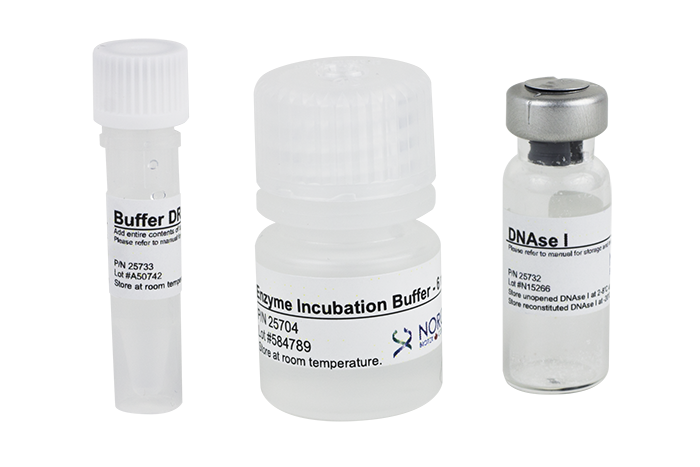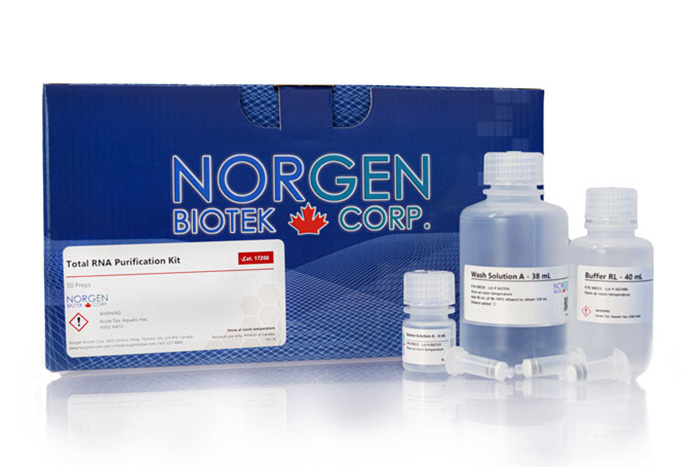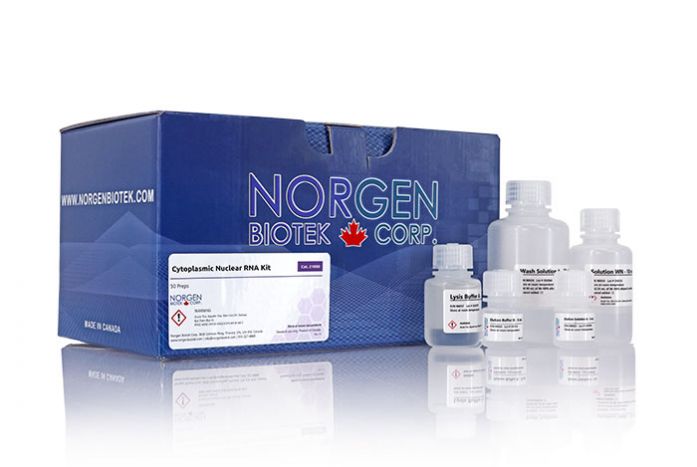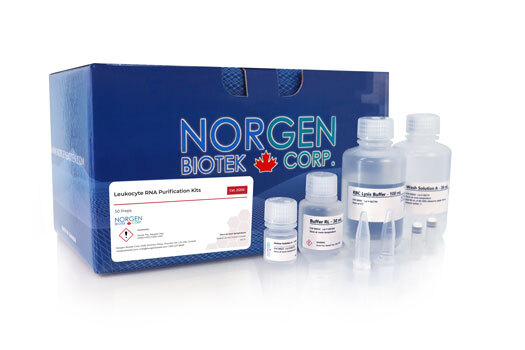Urine Exfoliated Cell and Bacteria RNA Purification Kit
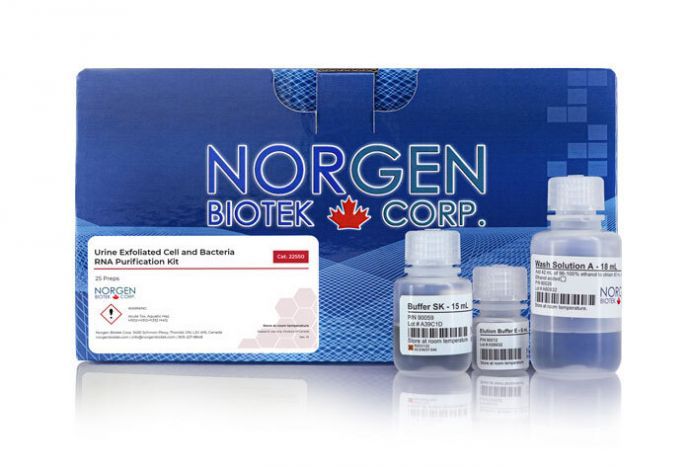
For research use only and NOT intended for in vitro diagnostics.
Urine Exfoliated Cell and Bacteria RNA Purification Kit
Register today to receive an exclusive 15% off* on your first order.
Supporting Data
Figure 1. Isolation and Detection of RNA from the Exfoliated Cells in 50 mL of Urine. RNA was isolated from the exfoliated cells in a 50 mL urine sample obtained from a healthy male without any spiking using Norgen's Urine (Exfoliated Cell) RNA Purification Kit. The bind, wash, and elute procedure was followed, and the purified RNA was recovered in 20 µL of the Elution Buffer. A dilution series of HeLa cells with known concentration (from 1 cell per mL to 1,000 cells per mL) was isolated in parallel as standards. Seven microliters of the 20 µL eluted RNA were then subjected to a 20 µL reverse transcription. One microliter of the reverse transcription was used in a 20 µL real-time PCR reaction with primers to detect the ribosomal S14 transcript. The red lines in the PCR baseline graph above correspond to the HeLa RNA standards, while the blue lines correspond to the successful PCR results when RNA isolated from the exfoliated cells in 50 mL of non-spiked urine was used as the template.
|
Kit Specifications
|
|
| Maximum Column Binding Capacity |
50 μg
|
| Volume of Urine Processed |
1-50 mL
|
| Maximum Input of Exfoliated Cells |
1 x 106
|
| Size of RNA Purified |
All sizes, including small RNA
(< 200 nt) |
| Time to Complete 10 Purifications |
20 minutes (for Exfoliated Cells)
30 minutes (for Bacteria)
|
| Average Yield |
~1μg RNA per 1 x 105 cells
(For Exfoliated Cells - Varies due to cell density sample) ~0.5μg RNA per 1 x 107 cells
(For Bacteria - Varies due to cell density sample)
|
Storage Conditions and Product Stability
All solutions should be kept tightly sealed and stored at room temperature. This kit is stable for 2 years after the date of shipment.
| Component | Cat. 22550 (25 preps) |
|---|---|
| Buffer SK | 15 mL |
| Wash Solution A | 18 mL |
| Elution Buffer E | 6 mL |
| Micro Spin Columns | 25 |
| Collection Tubes | 25 |
| Elution Tubes (1.7 mL) | 25 |
| Product Insert | 1 |
Documentation
FAQs
Spin Column
-
Incomplete lysis of cells.
Ensure that the appropriate amount of Buffer SK was added to the exfoliated cell pellet. Ensure that the appropriate amount of lysozyme containing TE buffer and Buffer SK are added to the bacterial pellet in order to completely lyse the cells.
-
Column has become clogged.
Do not exceed the recommended amounts of 50 mL of urine or 1 x 106 cells. The amount of starting material may need to be decreased if the column shows clogging below the recommended levels. See also “Clogged Column” below.
-
An alternative elution solution was used.
It is recommended that the Elution Solution E supplied with this kit be used for maximum RNA recovery.
-
Ethanol was not added to the lysate.
Ensure that the appropriate amount of ethanol is added to the lysate before binding to the column.
-
Ethanol was not added to the Wash Solution.
Ensure that 42 mL of 95% ethanol is added to the supplied Wash Solution A prior to use.
-
Low cell density in the sample
The cell number in different urine samples vary. While individuals with various diseases have >1000 exfoliated cells per mL of urine, a healthy male may have a number much lower than the 1000 cells per mL limit. It is possible that the total RNA isolated is not visible when resolved on an agarose gel or detected by spectrophotometry. In such cases, a larger input volume may be used. Alternatively, a more sensitive method such as BioAnalyzer or RT-PCR may be used for detection.
-
There is very little or no bacteria in the urine
The expected amount of bacteria in a urine sample is very little. A healthy individual usually has < 10,000 CFU/mL, therefore it is possible that the urine sample has very little bacteria present. The isolated RNA may not be visible when resolved on a gel. In such cases, a larger input volume may be used. Alternatively, a more sensitive method such as BioAnalyzer or PCR amplification may be used for detection.
-
Inefficient cell lysis.
Ensure that the appropriate amount of Buffer SK was added to the exfoliated cell pellet. Ensure that the appropriate amount of lysozyme containing TE buffer and Buffer SK are added to the bacterial pellet in order to completely lyse the cells.
-
Maximum number of cells exceeds kit specifications.
Do not exceed the recommended amounts of 50 mL of urine or 1 x 106 cells.
-
Too many bacteria present in the urine.
The urine sample that was applied to the column contained too many bacterial cells. Reduce the amount of urine used. Clogging can be alleviated by increasing the g-force and/or centrifuging for a longer period of time until the urine passes through the column.
-
High amounts of genomic DNA present in sample.
The lysate may be passed through a 25 gauge needle attached to a syringe 5-10 times in order to shear the genomic DNA prior to loading onto the column.
-
Centrifuge temperature too low.
Ensure that the centrifuge remains at room temperature throughout the procedure. Temperatures below 20°C may cause precipitates to form that can cause the columns to clog.
-
RNase contamination.
RNases may be introduced during the use of the kit. Ensure proper procedures are followed when working with RNA. Please refer to “Working with RNA” at the beginning of this user guide.
-
Procedure not performed quickly enough.
In order to maintain the integrity of the RNA, it is important that the procedure be performed quickly.
-
Lysozyme used may not be RNAse-free.
Ensure that the lysozyme being used with this kit is RNase-free, in order to prevent possible problems with RNA degradation.
-
Improper storage of the purified RNA.
For short term storage RNA samples may be stored at –20°C for a few days. It is recommended that samples be stored at –70°C for longer term storage.
-
The cells are old.
Older samples contain prematurely lysed cells which release RNase and can degrade RNA. Fresh urine samples are recommended.
-
RNA was not washed twice with the provided Wash Solution A
Traces of salt from the binding step may remain in the sample if the column is not washed twice with Wash Solution A. Salt may interfere with downstream applications, and thus must be washed from the column.
-
There is ethanol carryover
Ensure that the dry spin under the Column Wash procedure is performed, in order to remove traces of ethanol prior to elution. Ethanol is known to interfere with many downstream applications.

